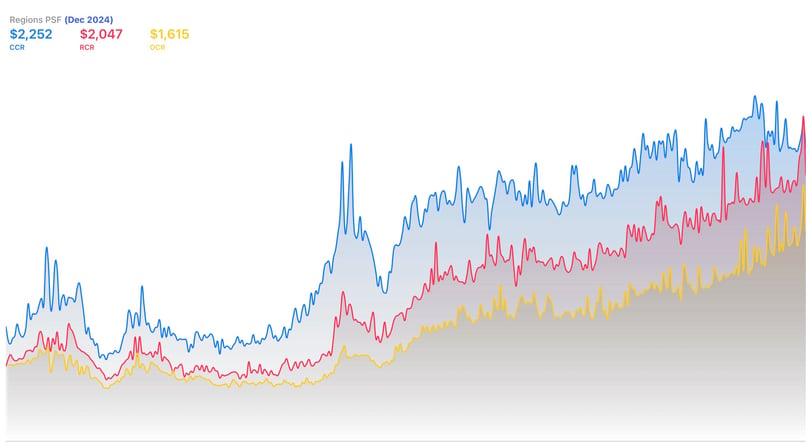Is Price Per Square Foot (PSF) Still Relevant in 2024? Here’s What Homebuyers Need to Know
For decades, Price Per Square Foot (PSF) has been the go-to metric for comparing property prices in Singapore. It’s simple, direct, and seems like an easy way to gauge whether a property is “cheap” or “expensive.” But in today’s property market, does PSF still hold the same relevance? With changing buyer preferences and new regulatory guidelines like the harmonization of floor area definitions by the URA, relying solely on PSF may no longer tell the full story. Here’s why.
Billy The Editorial Guy
12/4/20243 min read


What is PSF, and Why Do We Use It?
Price Per Square Foot (PSF) is calculated by dividing a property’s total price by its floor area in square feet. For instance:
A property priced at $1,000,000 with a size of 1,000 sq ft would have a PSF of $1,000.
Traditionally, PSF has been the easiest way for buyers to compare prices between properties. A lower PSF often signals a better deal, while a higher PSF might imply exclusivity or luxury. However, this simplistic view overlooks critical factors that influence the true value and livability of a property.
Why PSF Alone is Misleading in 2024
Recent regulatory changes and market trends have exposed the flaws of relying solely on PSF. Here’s why:
1. The Impact of Harmonized Floor Area Definitions
Previously, certain spaces like air-conditioner ledges, bay windows, and planters were excluded from Gross Floor Area (GFA) calculations. This led to inflated floor sizes that didn’t accurately reflect usable space.
With the harmonization of GFA definitions in 2023 by URA, these previously exempted areas are now included in the total floor area. As a result:
PSF figures may appear higher for newer developments because the floor area calculation now reflects all spaces.
Buyers benefit from more efficient layouts, as developers are incentivized to optimize usable space.
For instance, a 1,000 sq ft unit today may genuinely feel larger and more practical compared to a similarly sized older unit with inefficient designs.
2. PSF Ignores Layout and Usable Space
PSF focuses purely on size without accounting for how the space is used. Consider two 1,000 sq ft units:
Unit A has an efficient layout with spacious bedrooms and minimal wasted space.
Unit B includes large balconies and a long corridor that reduces the usable indoor area.
Although both have the same size and potentially similar PSF, Unit A offers better livability, making it a superior choice for most buyers.
3. PSF Doesn’t Account for Amenities and Facilities
Developments with luxury amenities—like sky gardens, infinity pools, or concierge services—often have higher PSF. While these features may justify the price for some buyers, they aren’t always practical for everyone. For instance:
A buyer who rarely uses communal facilities may not find value in paying a premium for a development with extensive amenities.
4. Total Price (Quantum) is Often Overlooked
Focusing on PSF can distract buyers from the total cost of the property. For example:
A smaller unit with a high PSF might have a lower overall price, making it more affordable for first-time buyers.
Conversely, a larger unit with a lower PSF might have a higher total price, which could stretch financing limits.
This highlights the importance of balancing PSF with affordability and financing considerations.
How Should Buyers Evaluate Properties in 2024?
Given the limitations of PSF, here’s how buyers can make better decisions:
1. Assess Layout Efficiency
Look for units with efficient layouts that minimize wasted space. Practical designs with well-sized rooms often provide better value than units with inflated floor areas.
2. Consider Amenities
Weigh the importance of amenities against their impact on PSF. Developments with extensive facilities may justify higher PSF but might not suit buyers who don’t use these features.
3. Look at Total Quantum
Focus on the total cost of the property rather than just PSF. A unit with higher PSF but a lower overall price might fit your budget better.
4. Think About Resale Potential
Properties in prime locations or with unique features may command higher PSF but could also offer better appreciation or rental yields.
Final Thoughts: Is PSF Still Relevant?
While PSF remains a helpful starting point for property comparisons, it should never be the sole metric for evaluating value. As Singapore’s property market evolves, factors like layout efficiency, amenities, and total affordability are becoming more critical.
At Homeasset.sg, we believe in helping buyers make informed, well-rounded decisions. If you’re navigating Singapore’s property market in 2024, let us guide you to properties that truly meet your needs. Contact us today to start your property journey!


